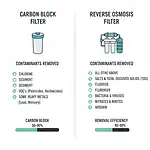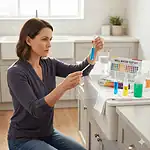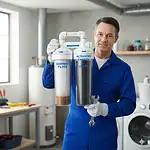Why Testing Well Water Is Essential
If your home relies on a private well, you’re responsible for ensuring your water is safe to drink. Unlike city water, which is regularly tested by municipalities, well water quality can change anytime—after heavy rains, droughts, nearby construction, or equipment wear.
Testing your well water at home isn’t just about peace of mind; it’s about protecting your health. Even clear, good-tasting water can contain bacteria, nitrates, or heavy metals that are invisible to the eye. The good news? With simple at-home kits and a bit of know-how, you can monitor your water’s safety and spot problems before they become serious.

To test your well water at home, collect a sample from your kitchen or outdoor faucet using a clean container, follow the test kit instructions to check for bacteria, pH, hardness, and nitrates, then compare the results with EPA safe drinking water standards or send a sample to a certified lab for confirmation.
Understanding What to Test For
The U.S. Environmental Protection Agency (EPA) recommends testing private wells at least once a year for coliform bacteria, nitrates, pH, and total dissolved solids (TDS). But if your water looks cloudy, smells like rotten eggs, or leaves orange stains, you may need additional tests.
Common Contaminants and What They Mean
| Contaminant | Why It Matters | Possible Source |
|---|---|---|
| Coliform Bacteria | Indicates potential disease-causing organisms | Septic system leaks, surface runoff |
| Nitrates / Nitrites | Dangerous for infants and pregnant women | Fertilizers, animal waste |
| Iron / Manganese | Causes stains, metallic taste | Natural mineral deposits |
| Hardness (Calcium, Magnesium) | Reduces soap lather, scale buildup | Groundwater minerals |
| Sulfur (Hydrogen Sulfide) | Rotten egg odor | Bacterial activity |
| Lead / Copper | Toxic heavy metals | Old pipes, plumbing corrosion |
| pH Level | Affects corrosion and taste | Soil acidity, mineral content |
Types of Well Water Tests
There are three main ways to test your well water:
- DIY Home Test Kits
Affordable and fast (results in minutes). These kits typically include test strips or color-coded reagents for parameters like pH, hardness, chlorine, nitrates, and iron. - Mail-In Laboratory Kits
You collect samples and mail them to a certified lab. These provide more accurate readings for bacteria and metals such as arsenic or lead. - Professional On-Site Testing
Certified technicians collect samples, test water flow, inspect the wellhead, and identify contamination risks. Ideal if you’ve had recurring water issues.
Step-by-Step: How to Test Your Well Water at Home
Step 1: Choose the Right Test Kit
Select a kit based on your concerns. For routine monitoring, choose a multi-parameter kit that tests for bacteria, pH, and hardness. For deeper analysis, add tests for heavy metals or pesticides.
Reputable brands (sold through Amazon or hardware stores) include:
Step 2: Prepare for Sampling
- Wash your hands and ensure all containers are clean and dry.
- Avoid using hot water or water softened by filtration—it can alter results.
- If you have a whole-house filter, sample before filtration, directly from the well source or outdoor spigot.
💡 Tip: Run the water for 5–10 minutes before collecting the sample to clear standing water in pipes.
Step 3: Collect the Water Sample
- Fill the sample bottle to the indicated line—don’t overfill.
- Avoid touching the inside of the cap or container.
- Label each sample (location and date).
- For bacteria testing, use sterile containers and refrigerate if shipping to a lab.
Step 4: Run the Tests
Most at-home test strips follow these steps:
- Dip the strip into the sample for a few seconds.
- Remove and wait for the color to develop.
- Match the strip to the color chart included in your kit.
If using reagent drops or digital readers, follow timing precisely—a few extra seconds can change results.
Step 5: Compare Results with EPA Guidelines
Use the EPA’s National Primary Drinking Water Regulations as your benchmark. Below are key safe limits:
| Parameter | Safe Limit (EPA) |
|---|---|
| pH | 6.5–8.5 |
| Total Dissolved Solids (TDS) | ≤500 mg/L |
| Nitrate (NO3) | ≤10 mg/L |
| Iron | ≤0.3 mg/L |
| Manganese | ≤0.05 mg/L |
| Coliform Bacteria | 0 (none detected) |
📘 Source: EPA.gov — Drinking Water Standards
When to Test More Frequently
You should test more than once a year if:
- There’s been flooding or heavy rain near your well.
- You notice changes in taste, color, or odor.
- Your well is shallow (<100 ft) or near septic systems or farms.
- You’ve recently installed new plumbing or filtration equipment.
Interpreting Your Results
If Bacteria Are Detected
- Shock chlorinate your well following local health department guidelines.
- Retest after two weeks. If bacteria persist, inspect the well cap and casing.
If Nitrate Levels Are High
- Avoid using the water for drinking, especially for infants.
- Install a reverse osmosis (RO) or ion exchange filter certified for nitrate removal.
If Hardness Is High
- Consider a water softener to prevent scale buildup.
If Metals Are Elevated
- Use a carbon block or RO system certified under NSF/ANSI 53 or 58 standards.
Signs You Should Test Immediately
| Sign | Possible Cause |
|---|---|
| Cloudy or milky water | Sediment or air bubbles |
| Orange or brown stains | Iron or manganese |
| Rotten egg smell | Sulfur bacteria |
| Bitter or metallic taste | High iron, low pH, or copper |
| Slimy buildup on fixtures | Iron bacteria |
| Algae-like film | Surface contamination |
Even subtle changes can indicate contamination entering the well from groundwater or plumbing corrosion.
Regular Testing Schedule (Recommended)
| Test Type | Frequency | Notes |
|---|---|---|
| Bacteria & Nitrates | Annually | Spring or after heavy rain |
| pH & Hardness | Every 2 years | Affects appliances |
| Metals (lead, iron, copper) | Every 3 years | Especially older homes |
| Pesticides / VOCs | Every 5 years | If near agriculture or industry |
Consistency is key—maintain a logbook or spreadsheet to track results over time.
Why Lab Confirmation Matters
Home test kits are useful for screening, but laboratory testing is more precise—especially for bacteria and metals. Certified labs use EPA-approved methods and provide official reports accepted by mortgage lenders and local authorities.
You can find a certified water testing lab through your state environmental agency or the EPA’s Safe Drinking Water Hotline (800-426-4791).
Simple Preventive Measures
- Inspect your well cap yearly — it should be tight and above ground level.
- Keep chemicals, fertilizers, and septic systems at least 50–100 feet away.
- Disinfect after maintenance — when replacing pumps or pipes.
- Install a sediment pre-filter before your whole-house or UV system.
- Check well casing for cracks or surface water pooling.
When to Contact a Professional
Call a licensed well contractor or water treatment specialist if:
- You have persistent bacteria despite chlorination.
- Water tests show arsenic, lead, or nitrates above limits.
- Your well pump is old (15+ years) or losing pressure.
Professionals can conduct pump flow tests, borehole inspections, and camera surveys to detect hidden issues.
Connecting Filtration After Testing
Testing is the first step; filtration is the solution. Once you understand your water profile:
- Use sediment + carbon pre-filtration for clarity and taste.
- Add UV sterilization for bacterial contamination.
- Install a reverse osmosis system for heavy metals or nitrates.
➡️ Learn more in our Filter Technologies Guide for in-depth info on how these filters work.
Next Steps
To improve your water quality after testing:
- Visit our Well Water Filtration Hub for system types and installation guides.
- Learn about Whole House Systems if you want full-home coverage.
- Explore Filter Technologies for choosing the right solution based on your results.
FAQs
Most kits are 80–95% accurate for common indicators like pH, hardness, and chlorine. For bacteria or metals, confirm with a certified lab.
Run it for 5–10 minutes to flush stagnant water from pipes and get a true sample.
Yes—but always keep an unfiltered sample, too. That way, you’ll know how well your system is performing.






